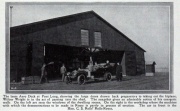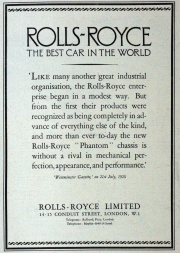Rolls-Royce: Cars



































































































Note: This is a sub-section of Rolls-Royce
1904 Frederick Henry Royce made his first car, a Royce, in his workshop in Cook Street, Manchester with the help of apprentices George Eric Platford and Tom Haldenby. The engine was a vertical tandem two-cylinder with 95mm bore and 127mm stroke. It had three-speeds and a reverse.
1904 April 1st. First trial run of the car
1904 18/19th April. One of his cars was used to carry H. Massac Buist, an Automobile Club observer from London to Margate in the course of a non-skid trial organised by Basil Humbert Joy. [1]
1904 May 4th. He was introduced to Charles Stewart Rolls at the Midland Hotel in Manchester and the pair agreed to a deal where Royce would manufacture cars, to be sold exclusively by Rolls. A clause was added to the contract stipulating the cars would be called Rolls-Royce.
1904 Engine (10 hp) made by Royce Motors at the Cook Street factory. Exhibit at Manchester's Museum of Science and Industry.
1904 December. Details of the 10 hp (also 15, 20 and 30 hp) petrol car.[2][3]
1904 December. Charles Stewart Rolls demonstrates a two-cylinder Rolls-Royce car at the Paris Motor Show. [4]
1905 February. Exhibited the four-cylinder model at the Olympia Motor Show and this was later known as the 'heavy twenty' model. The car as then sold to Arthur Harry Briggs
1905 March. Rolls-Royce car mentioned in advert in The Times. [5]
1905 March. Details of the cars; 10-hp two-cylinder; 15-hp three-cylinder; 20-hp four-cylinder; and 30-hp six-cylinder.[6][7]
1905 August. Details of the T.T. car.[8]
1905 September. Percy Northey comes second in the 1905 Tourist Trophy Race in a 'light-twenty' at an average speed of 33.7 mph
1905 October. Details of two eight-cylinder models.[9]
1905 November. Details of the eight-cylinder Landaulet.[10]
1905 December. Details of the 20-hp T.T. car.[11]
1905 Royce works on a V8 flat engine for a bonnetless town-carriage but it was never completed
1906 Produced 10 h.p. (Two-cylinder), 15 h.p. (Three-cylinder), 20 h.p. Four-cylinder), 20 h.p. (Six-cylinder) and 30 h.p. Eight-cylinder) shaft-drive models. Cars sold by C. S. Rolls and Co. [12]
1906 The Silver Ghost (1906-1925) was responsible for the company's early reputation. It had a 6-cylinder engine; 6,173 cars were built.
1906 May. Monte Carlo-London record
1906 Rolls wins the 1906 Tourist Trophy Race at an average 40 mph and 25 mpg
1906 Rolls take the car to New York and wins a race at the Empire City Track
1906 November. Details of their 40-45 hp cars.[13]
1906 Motor Show they exhibited two 40/50 but the press were not given a trial until the following April
1907 July. The 40/50 car takes the 15,000 miles record (finished 8th August) including the 1907 Scottish Reliability Trials. Also Non-stop record
1907 Autumn. A seven-seater 40/50 was voted the most handsome car at the 1907 New York Motor Show
1907 Six-cylinder 40/50 car was submitted to a series of tests by the RAC which included a total of 2,000 miles
1908 July. Opening of new Derby factory - details.[14]
1908 Ran a 15,000 mile trial under RAC scrutiny in a 40/50 Silver Ghost and the drivers were Rolls, Johnson, George Eric Platford and R. J. Mecredy. This car was later purchased by Dan Hanbury and ran well for another 350,000 miles.
1908 Ernest Hives joins the company as a tester. Briefly worked for them before in 1903
1908 March. At a Board Meeting Claude Johnson persuade the board to adopt the 'one-model' policy
1908 Two 70hp cars named White Knave and Silent Rogue were entered in the International Touring Car Trial. White Knave broke a piston but Percy Northey won his class.
1908 Silver Ghost wins the 1908 Scottish Reliability Trials [1]
1909 Percy Wilbraham Northey of Rolls-Royce Co summoned for speeding at Godalming. [15]
1909 June. Details of improvements made.[16]
1910 Harry Leonard Allen, 23, Manager at Rolls-Royce killed Christopher Read, 60, with his car on the Great North Road. [17]
1911 Silver Ghost driven from London to Edinburgh and back in top gear with a petrol consumption of 24.32 mpg. The same car was then driven at Brooklands with adjustment and attained a speed of 78.26 mph. [1]
1913 They win the Austrian Alpine Contests over a course of 1,654 miles [1]
1913 July. Details of a trial with the 40-50hp car.[18]
1913-1917 For a list of the models and prices see the 1917 Red Book
1914 September. Supplied chassis for armoured cars
1914 Listed as motor car manufacturers. Speciality: British-made six cylinder Rolls-Royce cars. [19]
1920 November. Exhibited at the Motor Car Show at Olympia and the White City with three cars all with the 40-50 hp six-cylinder engine. [20]
1921 The company opened a second factory in Springfield, Massachusetts (in the United States to help meet demand), where a further 1,701 "Springfield Ghosts" were built. This factory operated for 10 years, closing in 1931. Its chassis was used as a basis for the first British armoured car used in both world wars. In the 1920s Charles Jenner chief engine draughtsman. Day oversaw chassis design and Ivan Everden coordinated the work of the chassis engineers and the coachbuilding companies that bodied the chassis.
1922 The Bombay to Poona reliability trials and hill-climbing contest resulted in three Rolls-Royce cars finishing first, second and third. The fastest time was made by a Rolls-Royce landaulette, which ran up the Ghauts in 11 minutes.[21]
1925 The first of the Phantoms appeared
1929 Won the Schneider trophy
1925 2nd May. The New Phantom model introduced [1]
1931 The company acquired rival car maker Bentley, whose finances were unable to weather the Great Depression. From then until 2002, Bentley and Rolls-Royce cars were often identical apart from the radiator grille and minor details.
1946 Rolls-Royce and Bentley car production moved to Crewe.
1951 Exhibitor at the 1951 Motor Show in the Car Section.
1959 It opened at Mulliner Park Ward, London as the company started to build bodies for its cars for the first time: previously it had built only the chassis, leaving the bodies to specialist coach-builders.
1963 Motor Show exhibitor. Showed Phantom V and Silver Cloud III. [22]
List of Models
- Rolls-Royce: 10 hp 1904–06
- Rolls-Royce: 15 hp 1905–05
- Rolls-Royce: 20 hp 1905–08
- Rolls-Royce: 30 hp 1905–06
- Rolls-Royce: V-8 1905–06
- Rolls-Royce: 20 1922–29
- Rolls-Royce: 20/25 1929–36
- Rolls-Royce: 25/30 1936–38
- Rolls-Royce: 70 1908 Cars 707, 726, 737 and 751. Experimental with overhead valves.
- Rolls-Royce: Silver Ghost 1906-26. The 40/50 model
- Rolls-Royce: Silver Dawn 1949-55 - (761 produced)
- Rolls-Royce: Silver Wraith 1946-59 - (1,783 produced)
- Rolls-Royce: Silver Spirit 1980-92
- Rolls-Royce: Phantom I 1925-29
- Rolls-Royce: Phantom II 1929-35
- Rolls-Royce: Phantom III 1936-39
- Rolls-Royce: Wraith
- Rolls-Royce: Phantom IV 1950-56
- Rolls-Royce: Phantom V 1959-68 (519 produced)
- Rolls-Royce: Phantom VI 1968-92 (373 produced)
- Rolls-Royce: Silver Wraith 1946-59
- Rolls-Royce: Silver Dawn 1949-55
- Rolls-Royce: Silver Shadow 1965-92
- Rolls-Royce: Silver Cloud 1955-59 - (2,359 produced)
- Rolls-Royce: Silver Cloud II 1959-65 - (5,013 produced)
- Rolls-Royce: Silver Cloud III 1962-65 - (2,359 produced)
- Rolls-Royce: Silver Spur
- Rolls-Royce: Camargue 1975-86 - (530 produced)
- Rolls-Royce: Corniche 1971-94 - (452 produced) - Model I and II
See Also
Sources of Information
- ↑ 1.0 1.1 1.2 1.3 1.4 The Early History of Motoring by Claude Johnson
- ↑ Automotor Journal 1904/12/03
- ↑ Automotor Journal 1904/12/10
- ↑ The Times, Thursday, Dec 22, 1904
- ↑ The Times, Wednesday, Mar 22, 1905
- ↑ The Autocar 1905/03/04
- ↑ The Autocar 1905/03/11
- ↑ The Autocar 1905/08/26
- ↑ Automotor Journal 1905/11/11
- ↑ The Autocar 1905/11/11
- ↑ The Autocar 1905/12/23
- ↑ The Automobile Vol. III. Edited by Paul N. Hasluck and published by Cassell in 1906.
- ↑ Automotor Journal 1906/12/08
- ↑ Automotor Journal 1908/07/18
- ↑ The Times, Tuesday, Feb 23, 1909
- ↑ Automotor Journal 1909/06/12
- ↑ The Times, Friday, Jan 14, 1910
- ↑ The Autocar 1913/07/26
- ↑ 1914 Whitakers Red Book
- ↑ The Engineer of 19th November 1920 p498
- ↑ The Engineer 1922/04/14
- ↑ 1963 Motor Show
- Wikipedia
- 1961 Guide to Key British Enterprises
- The Rolls-Royce Motor Car and Bentley since 1931 by Bird, Hallows and James. Published 1964.

